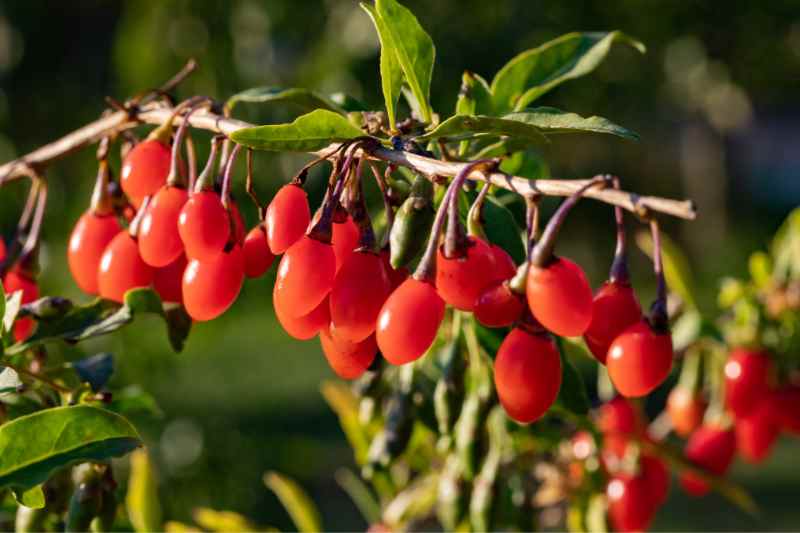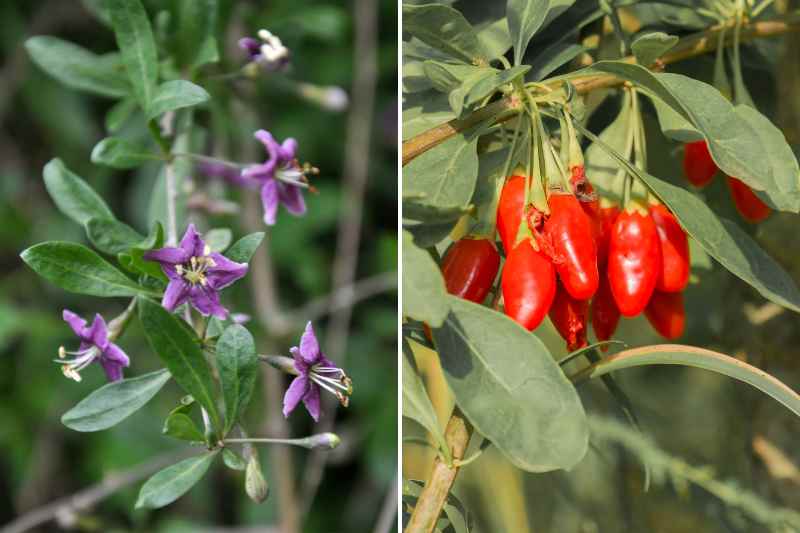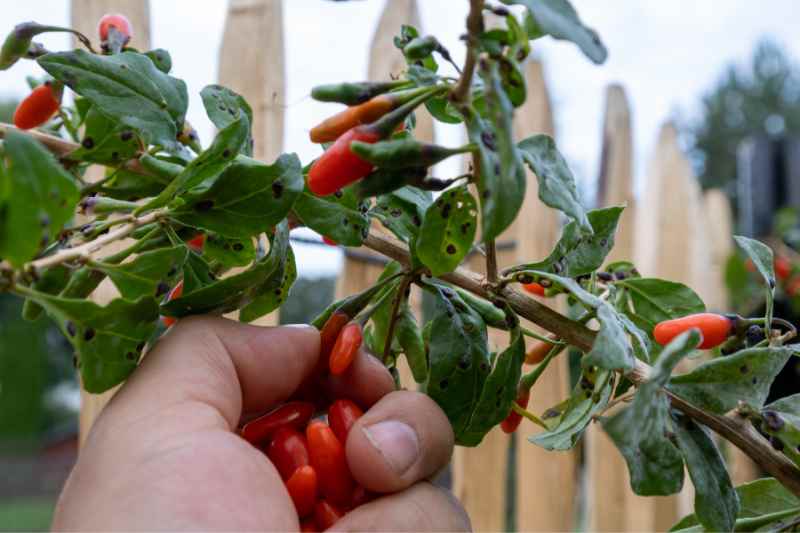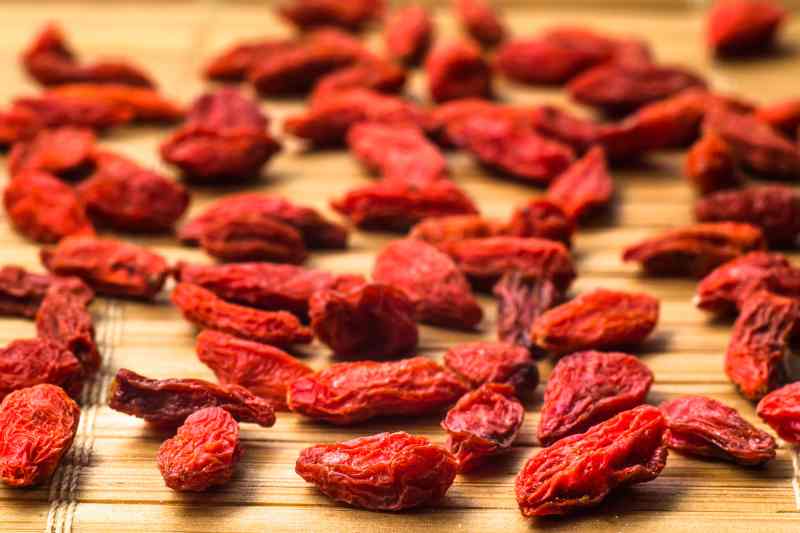Goji berries, red treasures with priceless virtues, stand at crossroads between millennia-old tradition and modern nutrition. Cultivated with care in distant Asian valleys, they represent an exceptional source of wellbeing, enriching diet with their wealth of nutrients. Let us embark on a fascinating journey from harvest to storage of goji berries, revealing secrets to capture their essence and preserve their integrity. Through proven techniques and sound advice, we will explore how these small berries can be picked at peak ripeness and stored with care to ensure their incredible range of benefits is available year-round, bringing a touch of vitality and colour to daily life.

Barbary wolfberry
The common lycium (Lycium barbarum), more commonly known as goji berry, belongs to Solanaceae family, like tomatoes, chillies or potatoes. Native to mountainous regions of Asia, notably China, where it has been cultivated for millennia for its nutrient-rich fruits, lycium has gained popularity worldwide for its red berries regarded as a superfood. These berries, renowned for antioxidant properties and richness in vitamins, minerals and amino acids, are used both in food and in traditional medicine. Cultivation of lycium requires sunny, well-drained climate and can adapt to various types of soil provided they drain well. Plant is relatively hardy and tolerates dry conditions, but particular attention must be paid to harvest and pruning to ensure abundant berry production.
Among Lycium barbarum there are a few varieties that differ from the type species in yield, size of the bush or berry colour (yellow for Lycium 'Amber Sweet', for example). Note that other Lycium species also exist, such as Lycium chinensis.

Harvesting goji berries
Harvesting goji berries, those small red fruits with recognised nutritional virtues, requires attention and delicacy to maximise quality and flavour.
Th best time to harvest
Goji berries generally reach ripeness in late summer or early autumn, ideal period for harvest. This season allows berries to fully develop sweet flavour and nutrient concentration. It is crucial to monitor plants regularly, as berries ripen at different times, potentially requiring several passes to pick fruits at peak ripeness.
Note that harvest is usually optimal only from around fourth year of cultivation.
Identifying ripe berries
Ripe goji berries are characterised by bright red colour and slight softness to the touch. They should detach easily from the branch without effort. Avoid picking berries that are still firm or orange in colour, a sign they have not yet reached full ripeness.
Harvesting techniques: hand-picking or comb
- Hand-picking: Gentle method to harvest goji berries is hand-picking, which helps avoid damage to berries and branches. Use fingers to gently detach each berry from its peduncle.
- Using a comb: For faster harvest, some choose to use a berry comb. Slide tool gently through branches to dislodge berries. Although more efficient, this method can sometimes damage fruits and plants, so use with care.

Tips for an optimal harvest
- Harvest early morning or late afternoon: Cooler temperatures reduce risk of damage to berries and make picking easier.
- Wear gloves!: Goji branches can be thorny, and gloves protect hands while allowing delicate handling of fruits.
- Use shallow baskets or containers: To avoid crushing berries under their own weight, harvest into shallow containers and avoid stacking too high.
- Store berries properly: Once harvested, goji berries can be dried or kept chilled to extend shelf life. If drying, spread in single layer under direct sun or use a food dehydrator.
Storing goji berries
Storage of goji berries after harvest is essential to enjoy their benefits throughout the year. Drying is a popular preservation method that retains nutrients and concentrates flavours. Here are different drying techniques and tips to store dried goji berries.
Drying
- Sun-drying: Spread goji berries in a single layer on a tray and leave to dry in sun for several days. This traditional method is ideal in low-humidity regions. Cover with a net to protect from insects and dust.
- Oven drying: Arrange berries on a baking tray in a uniform layer and place in oven preheated to lowest possible temperature (around 50–60°C) for a few hours. Keep oven door slightly ajar to allow moisture to escape.
- Using a dehydrator: If you have a food dehydrator, spread berries across trays and follow manufacturer instructions. Dehydrator provides even drying and is generally quicker than sun-drying.

Storing dried berries
- In an airtight jar: Place dried berries in glass airtight jars and keep in cool, dry place away from direct sunlight. This preserves freshness and flavour.
- In the refrigerator: For extended storage, you can also keep dried berries in an airtight container in refrigerator. This method is particularly useful in hot, humid climates.
- In the freezer: Dried goji berries can be frozen to maximise shelf life. Ensure berries are completely dry before placing in freezer bags to avoid ice formation.
Shelf life
- Dried goji berries stored in cool, dry place can keep up to one year without significant quality loss.
- In refrigerator, they can last even longer, up to two years.
- In freezer, goji berries can be kept for two years or more, but best to use within one year for best quality.
Tips and advice
Avoid green berries: toxicity
Green goji berries are not yet ripe and may be toxic if consumed in large quantities (remember plant belongs to Solanaceae!). It is crucial to wait until they reach bright red colour before picking. This precaution lets you fully enjoy nutritional benefits without risking adverse effects.
Use appropriate tools for picking
For effective and safe harvest, use appropriate tools such as clean, sharp pruning shears and gardening gloves to protect hands from thorny branches. These tools make picking easier and help prevent damage to plants and fruits, ensuring abundant, healthy harvest.
Store berries in cool, dry place
After harvest, remember to store goji berries in a cool, dry place to preserve freshness and extend shelf life. Dried berries should be kept in airtight containers away from direct sunlight and humidity, which prevents mould growth and nutrient degradation.
Turn berries into juice, jam, etc.
Goji berries offer great culinary versatility and can be turned into a variety of products such as juice, jam, or even incorporated into cooked dishes. Turning berries into juice or jam not only diversifies diet but also provides creative preservation methods. These preparations are an excellent way to include goji berries and their benefits in daily diet.

































Comments